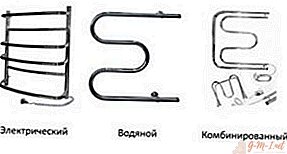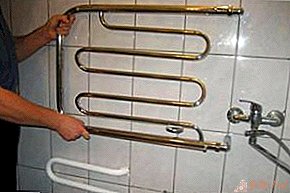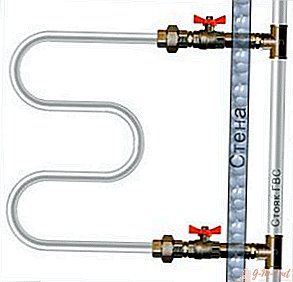 A heated towel rail is a heating element that consists of two or more bent metal pipes and is in the bathroom of almost every apartment. Besides the fact that it serves as an additional source of heat and prevents the formation of mold and dampness, it is also an excellent decoration option.
A heated towel rail is a heating element that consists of two or more bent metal pipes and is in the bathroom of almost every apartment. Besides the fact that it serves as an additional source of heat and prevents the formation of mold and dampness, it is also an excellent decoration option.
Preparing to replace a heated towel rail in the bathroom
If you decide to change the coil in the bathroom, you should find out some details that will help facilitate and control the process. The heated towel rail is of three types:
- water, through which hot water circulates;
- electric, works from the socket;

- combined, combines both types: when the hot water supply is turned off, the tubular electric heater is heated, in the absence of electricity, heating is carried out due to boiling water.
Before replacing the heated towel rail, you must first examine the area in which the work will be carried out and pay attention to:
- on the state of communications in your apartment, the method of circulation of the coolant;
- on the surroundings, namely walls, ceilings, floors (for example, a suspended ceiling will complicate the process, as it will not allow bending pipes for threading).
If, in addition to replacing the radiator, plans include transferring it to another wall, then you need to coordinate these works with the management company, order an individual project and make a hydraulic calculation. Talk with neighbors living below and above about the condition of their pipes to prevent flooding. You can also warn them about turning off the hot water riser for a certain time.
Do-it-yourself replacement of the heated towel rail
If you decide to entrust this matter to professionals, then make sure that the company is reliable and that you have the basic documentation, which includes the SRO certificate of approval. The dismantling and installation of a new heated towel rail is not simple, requires special knowledge and takes 2-3 hours, but after studying the sequence, you can replace the coil with your own forces.
To do this, you will need:
- heated towel rail;
- mounting brackets;

- plastic pipes;
- special cutting pliers;
- level;
- adjustable and tubular wrenches;
- sealant for connections;
- Bulgarian.
Removing the old heated towel rail
It is better to perform these procedures in the daytime, when most of the neighbors will be outside the house, since it is necessary to turn off the hot water supply. Before disassembling, contact the management company with a statement about the power off of the riser, you must first agree on the day, time and period for which the stop will be made. It is better to clarify the procedure for carrying out this procedure in advance, since it may be paid and require the collection of additional documents.
ATTENTION! The housing department does not have the right to refuse shutdown if there is a statement and all conditions are met.
After turning off the water, drain all contents from the riser. Next, with the help of a grinder, the old coil is dismantled, first the lower part, then the upper one. Additional help may be needed at this point to hold the old unit. The trimmed ends are cleaned, the old paint is removed, the burrs are removed for further connection with new pipes.
Install a new device
 It is recommended to choose a device in a specialized store, you should approach the issue carefully, choosing high-quality materials suitable for design, so that in the future there will not be a situation in which you will need to replace it again due to a poorly selected device.
It is recommended to choose a device in a specialized store, you should approach the issue carefully, choosing high-quality materials suitable for design, so that in the future there will not be a situation in which you will need to replace it again due to a poorly selected device.
IMPORTANT! A stainless steel dryer is perfect for apartment buildings, because it can withstand up to 10 bar and is not subject to destruction and corrosion, and brass devices can be used in private buildings, because they can not withstand pressure above 8 highways.
First you need to mark where the new heated towel rail will be placed and attach the brackets. It must be placed at a distance of 2-6 centimeters from the wall, depending on the diameter of the pipe (the larger it is, the farther from the wall).
There can be three installation options:
- if the pipe diameter and the center distance coincide, then alteration is not required;
- if the diameter is very different or the communications are in very poor condition, then welding is necessary;
- use of threaded connections.
Towel connection
Steps for connecting a heated towel rail:
- To begin with, thread is applied to metal pipes, if the old one is not preserved.
- Pipes are connected to the hot water supply pipe, for this the apparatus for welding is preheated and special nozzles are heated, on which the coupling and pipe are mounted at the same time, due to heating they melt and reliably connect to each other. For free circulation of water, the feed element should have a slight slope towards the fixture, and diverting in the opposite direction (approximately 2-3 mm).

- Further, to prevent water leakage, it is recommended that all joints be well sealed and walk with a special paste that prevents leakage.
- The device is finally fixed with special fasteners.
- For the smooth functioning of the system, you can use bypasses (spare channels) and shut-off valves (located on the supply and discharge channels), thanks to which, in the event of an emergency, the system will continue to work and allow repairs to be made without disconnecting the entire riser and suspending water.
Connectivity Test
Upon installation, you should invite a representative of the management company to verify compliance with the actions taken. After starting the water, make sure all joints are tight and that the heated towel rail is functioning properly.
IMPORTANT! Taps for filling with water must be switched on smoothly, as there is a possibility of a water hammer.
Installing an electric heated towel rail
This type of coil is much easier to install and allows you to include it only when necessary. The first step is to dismantle the old device in the same way as indicated in the article above. Next, the pipes are connected through which the water circulates through the common system.
Then it is necessary to determine the connection of the unit to electricity, which can be carried out either through a wall outlet or from a switchboard. The outlet should be installed at a far distance from an open source of water, and the type of enclosure must be waterproof. The second option requires the presence of pre-conducted wires in the bathroom or you will have to disassemble the decorative finish for them. Next, mark the holes in the wall with a level, drill holes and install a heated towel rail on the fasteners.
Now you can replace the heating device yourself, thereby saving money or invite professional craftsmen and completely control the process.




Leave Your Comment